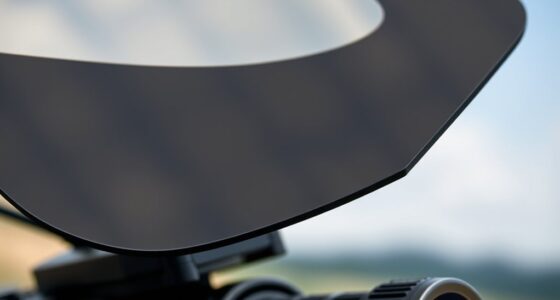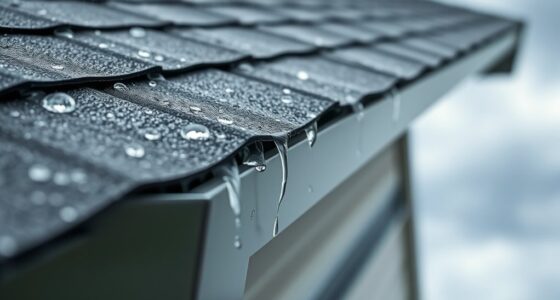To safeguard your materials from UV damage, start by understanding how UV rays cause fading, brittleness, and deterioration. Use UV-resistant coatings, films, or covers for outdoor fabrics, plastics, and paints, and consider DIY natural barriers like zinc oxide or plant shade. Regular maintenance and choosing the right protective products help guarantee long-lasting protection. Keep exploring to discover more tips on selecting, applying, and maintaining effective UV shields for your materials.
Key Takeaways
- UV rays can cause fading, brittleness, and deterioration of outdoor fabrics, plastics, and paints, reducing material lifespan.
- Use UV-protective coatings, films, or sprays designed for specific materials to block or reflect harmful rays effectively.
- Natural methods like shading, planting trees, or applying mineral-based DIY barriers offer eco-friendly UV protection.
- Regularly inspect, clean, and reapply UV protectants to maintain their effectiveness and extend material durability.
- Choose UV protection products based on material type, exposure level, and ensure proper maintenance for optimal results.
Understanding UV Rays and Their Impact on Materials

Although UV rays are invisible to the naked eye, they can cause significant damage to materials over time. The UV wavelength, which ranges from 100 to 400 nanometers, penetrates surfaces and breaks down their molecular structure. This process weakens materials like plastics, fabrics, and paints, leading to fading, brittleness, and deterioration. Atmospheric scattering plays a key role here, as it disperses UV rays in the atmosphere, reducing some exposure but not eliminating it. When UV rays reach your materials, they initiate chemical reactions that cause fading and breakdown. Recognizing the impact of UV radiation is vital for protecting your belongings. By understanding how UV wavelength and atmospheric scattering impact materials, you can better determine when and how to apply protective measures.
Common Materials That Require UV Protection

Many common materials are vulnerable to UV damage and need protection to maintain their appearance and durability. UV sensitive fabrics, like outdoor clothing and upholstery, can fade, weaken, or become brittle when exposed to sunlight. Plastic degradation is another concern; plastics used in outdoor furniture, signage, and packaging can crack, warp, or lose their strength over time. Without protection, these materials deteriorate faster, leading to costly replacements and reduced lifespan. You should be aware of which materials are most at risk so you can take preventive steps. Applying UV protective coatings or using protective covers can considerably prolong their usability. Understanding these vulnerable materials helps you make smarter choices to keep your belongings looking good and functioning well longer. Additionally, UV resistance is a critical factor to consider when selecting materials for outdoor use, ensuring they withstand prolonged sun exposure without significant damage.
Types of UV Protective Coatings and Films
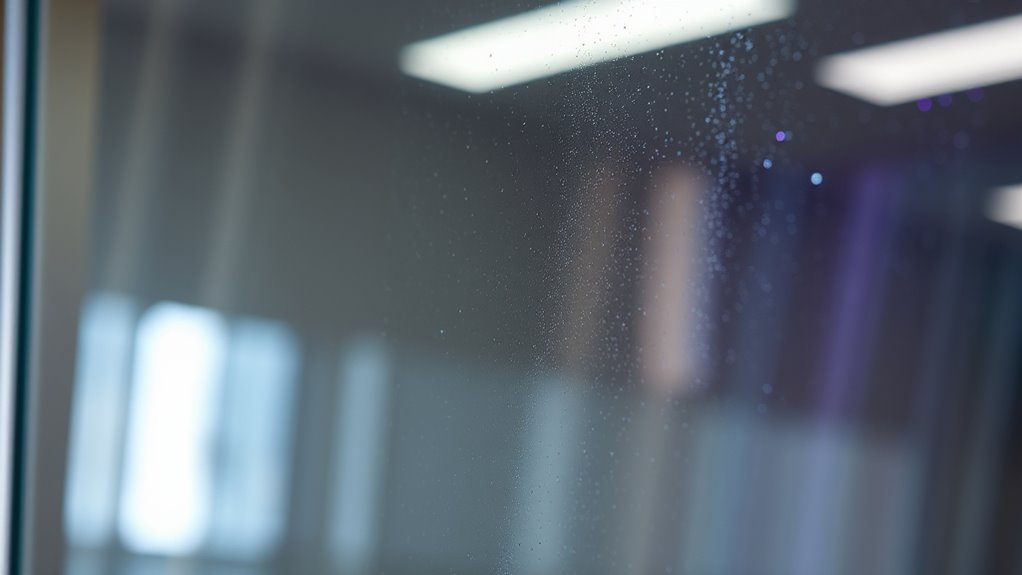
Have you considered how UV protective coatings and films can extend the life of your materials? There are several options to choose from:
UV protective coatings and films help extend your materials’ lifespan while maintaining their appearance.
- Clear UV coatings: These provide excellent UV coating durability while maintaining high film transparency, so your materials stay protected without sacrificing appearance.
- UV-blocking films: Applied to glass or plastics, they block harmful rays while remaining nearly invisible, offering discreet protection.
- Reflective coatings: These reflect UV rays away, reducing damage, though they may slightly affect transparency.
- Selecting the appropriate UV protection method can also help support environmental considerations by minimizing the impact on surrounding ecosystems and reducing maintenance needs.
Each type offers unique benefits, so consider your needs for durability and visual clarity. Properly selected coatings and films ensure your materials resist UV damage, prolonging their lifespan with minimal impact on aesthetics.
Natural and DIY Methods for UV Shielding
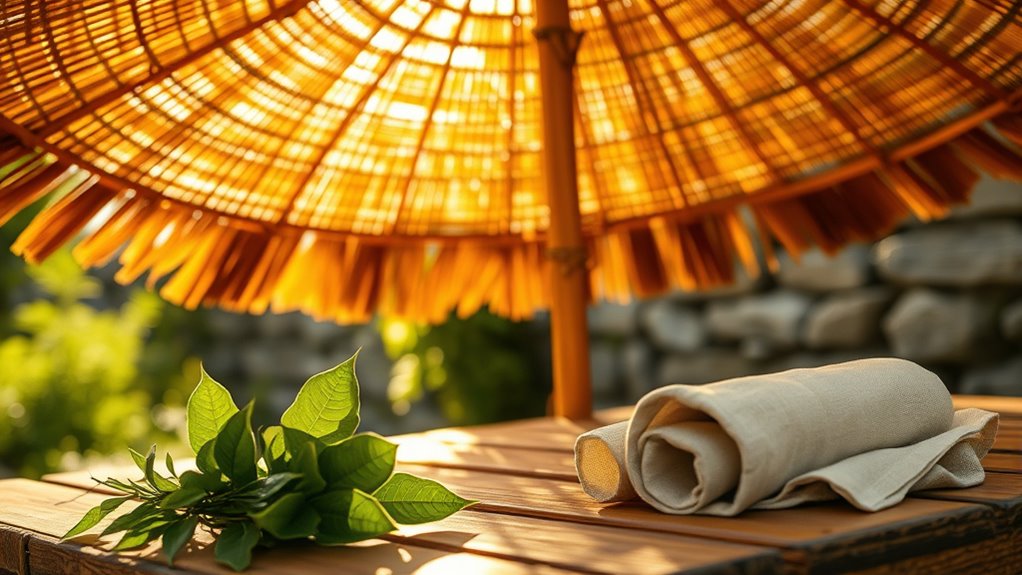
While commercial UV protective coatings are effective, natural and DIY methods can also offer practical ways to shield your materials from harmful rays. One simple approach is using natural sunscreen ingredients, like zinc oxide or titanium dioxide, which can be applied as a protective layer. These ingredients act as DIY barriers, reflecting and absorbing UV rays much like commercial products. You can create homemade sprays or coatings using these minerals mixed with carrier oils or water. Additionally, shading your materials with fabric covers, umbrellas, or placing them indoors reduces UV exposure naturally. Planting trees or using natural materials as barriers also helps block sunlight. These natural and DIY solutions are affordable, eco-friendly, and easy to implement, making them a great first step in UV protection.
Choosing the Right UV Protection Products
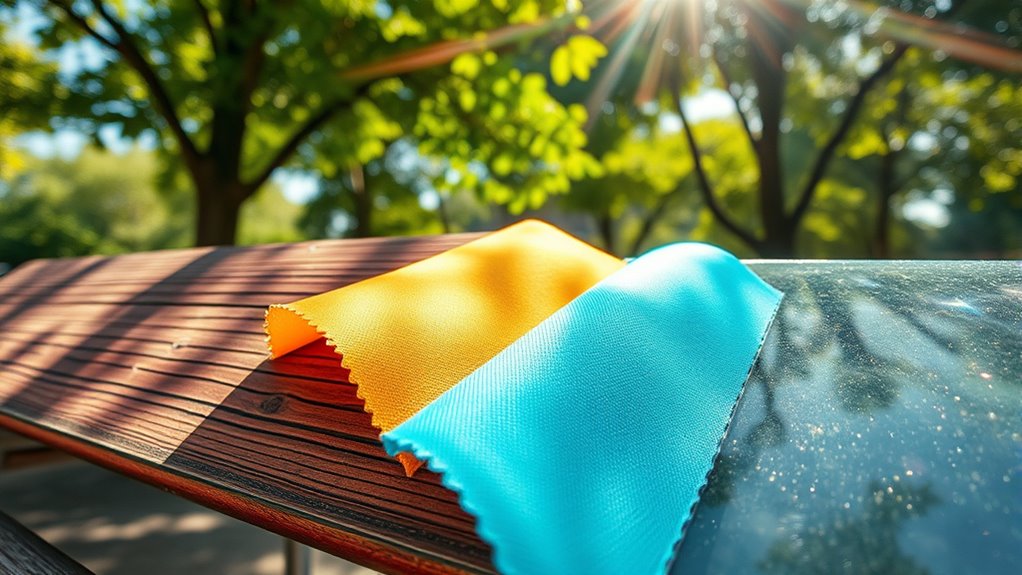
Choosing the right UV protection products involves understanding the specific needs of your materials and environment. To effectively block harmful UV rays, consider these factors:
- UV absorption: Select products that absorb UV radiation, preventing it from damaging your materials.
- UV reflection: Choose coatings or films that reflect UV rays away from surfaces, reducing exposure.
- Compatibility: Guarantee the product suits your material type—wood, fabric, or plastic—and matches environmental conditions like exposure level and climate.
Maintenance and Best Practices for Long-lasting UV Defense

Maintaining the effectiveness of your UV protection products requires regular care and attention. To combat UV degradation, inspect protective fabrics and coatings frequently. Clean fabrics gently with mild soap and water, avoiding harsh chemicals that can weaken materials. Store items indoors or in shaded areas when not in use to prevent unnecessary sun exposure. Reapply UV protectants as recommended by manufacturers to restore their barrier. Here’s a quick guide:
| Action | Frequency | Notes |
|---|---|---|
| Clean protective fabrics | After heavy use or dirt | Use mild soap; avoid abrasives |
| Reapply UV protectants | As specified | Follow product instructions |
| Store away from sun | When not in use | Keep in shaded or indoor storage |
| Inspect for damage | Monthly | Replace if UV degradation is evident |
| Avoid harsh chemicals | During cleaning | Use gentle cleaners |
| Regularly monitor UV resistance | Periodically to ensure ongoing effectiveness | Be aware that UV degradation can compromise protection. |
Frequently Asked Questions
How Do UV Protective Coatings Affect Material Appearance?
UV protective coatings can slightly alter your material’s appearance, but they mainly preserve its clarity and color. You might notice a subtle matte or gloss finish, depending on the coating type, but it shouldn’t substantially impact the overall look. These coatings help maintain your material’s vibrancy over time, ensuring that colors stay true and clarity remains sharp, even after prolonged sun exposure.
Are UV Protections Safe for All Environmental Conditions?
UV protections are generally safe for most environmental conditions, but you should consider their environmental impact and chemical safety. Some formulations may release harmful chemicals if not properly tested, especially in extreme weather. Always choose products with proven safety standards, and follow application instructions closely. This guarantees your protection doesn’t harm the environment or pose health risks, giving you peace of mind in diverse conditions.
Can UV Protection Be Applied to Already Weathered Materials?
You can apply UV protection to already weathered materials, but don’t expect miracles overnight. Weathered restoration requires proper surface prep to make certain coating adhesion, so clean and lightly sand the surface first. This helps the UV coating adhere better and provides effective protection. Keep in mind, the older and more damaged the material, the harder it is to achieve a seamless finish. It’s a bit of a tall order, but with patience, you can improve durability.
What Is the Lifespan of Common UV Protective Films?
The lifespan of common UV protective films typically ranges from 5 to 10 years, depending on exposure and quality. You’ll notice UV degradation over time, which can reduce the film’s effectiveness. To maximize film longevity, regularly inspect for signs of wear or peeling, and clean the surface properly. Proper application and maintenance make certain you get the most out of your UV protective film, keeping your materials shielded longer.
How Do I Test if My Material Has Effective UV Protection?
To test if your material has effective UV protection, start with UV testing methods like UV light exposure or UV transmittance meters. Observe any material discoloration over time; minimal or no discoloration indicates good UV protection. You can also compare untreated versus treated samples under UV conditions. Regular testing helps guarantee your material’s UV protection remains effective, preventing damage and maintaining appearance.
Conclusion
Remember, prevention is better than cure. By understanding UV rays and choosing the right protective methods, you can keep your materials looking great for years. Whether you opt for coatings, films, or natural solutions, regular maintenance guarantees your investment lasts. Don’t forget, a stitch in time saves nine—so take action now to shield your belongings from UV damage. Protecting your materials today means they’ll serve you well tomorrow.


